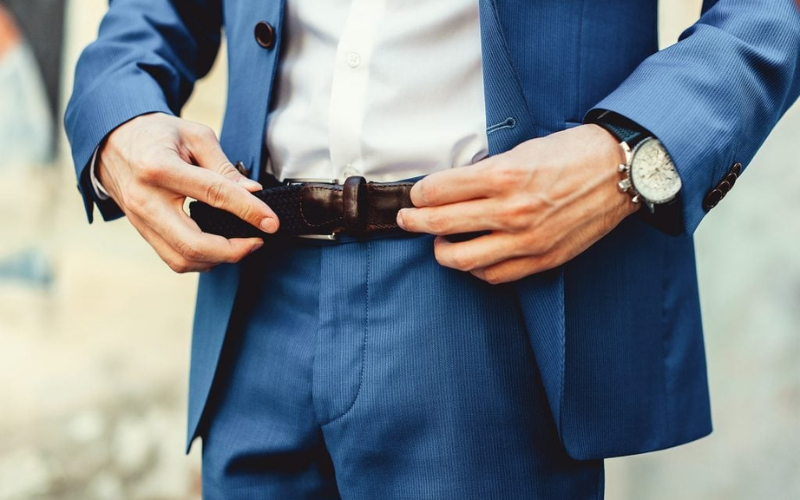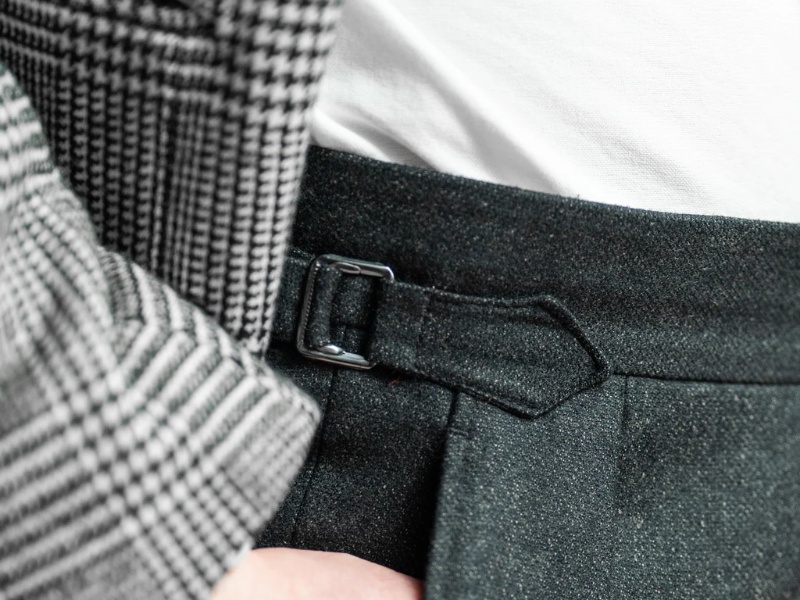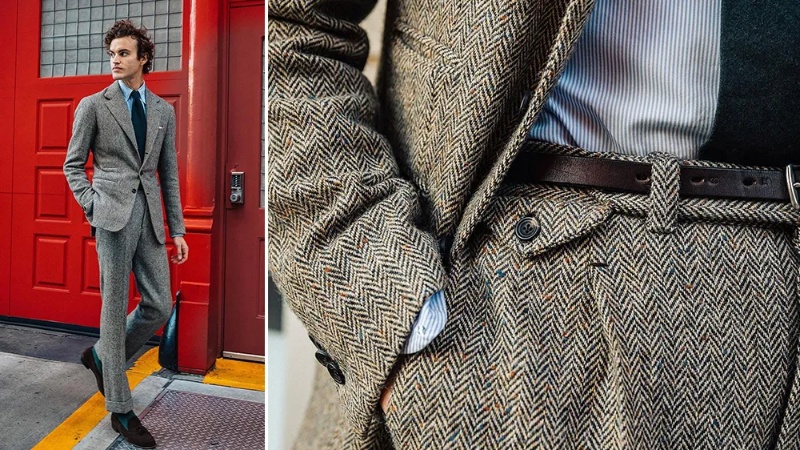Do you have to wear a belt with a suit? If you’re asking this question from a functioning perspective, then yes, you can wear a belt with a suit, if you feel like it would help you feel more “grounded and safe with your trouser”. But if you care more about dressing well, there are more to it than a simple yes or no. It’s a question of style, tradition and personal expression. In this article, we’ll explore whether a belt is truly necessary with a suit, what the experts recommend, and how the right (or wrong) choice can affect the overall elegance of your outfit.
1. Do you have to wear a belt with a suit?
As a tailor who has spent years crafting suits to fit the individual contours of each client, let me answer this question simply: no, you do not have to wear a belt with a suit. And in many cases, you shouldn’t.
Traditional tailoring is built on the principle of fit.
A well-made suit, especially one that has been properly measured and altered, is designed to stay in place on its own. The waistband of the trousers should sit comfortably on your natural waist, hugging you just enough to provide support without the need for external help.
In fact, when a suit fits perfectly, adding a belt can disrupt the clean lines and visual flow of the ensemble. Think of a suit like a finely drawn sketch. Each line, each contour, meant to guide the eye in one smooth motion. A belt, especially a bulky one, can cut that line across the midsection, creating an unnecessary break in the silhouette. That’s why in classic tailoring, the beltless look is often the mark of a suit worn well and chosen wisely.
Of course, not all suits come off the rack with a perfect fit, and not every occasion demands strict formality. Sometime, you do need to wear a belt with a suit. But if you’re aiming for a timeless, elegant appearance, the answer remains: with a properly tailored suit, you don’t need a belt. In most cases, you’re better off without it.

2. When is it acceptable to wear a belt with a suit?
While the ideal suit may not call for a belt, there are certain occasions when wearing one is perfectly acceptable, even practical.
One of the most common scenarios is when you’re wearing a ready-to-wear suit that hasn’t been altered yet. Off-the-rack trousers often come with belt loops by default, and without a tailored fit, a belt may be necessary to keep everything comfortably in place. In these cases asking do you wear a belt with a suit isn’t necessary at all. The belt serves less as a statement and more as a functional support.
Wearing a belt also becomes more acceptable when the suit itself leans toward the casual side. Think of business casual environments or relaxed social settings where the structure of the outfit is softer, and the formality is dialed down. A lightweight cotton or linen suit, for example, paired with loafers or unstructured tailoring, can work well with a subtle leather belt, even better if it complements your shoes and accessories. In these moments, the belt doesn’t feel out of place but a part of a cohesive, laid-back look.

Lastly, some gents choose to wear a belt not out of necessity, but as a deliberate style choice. A sleek, minimalist belt can add a touch of character to an otherwise understated ensemble, ofc when matched thoughtfully with your shoes or watch strap.
The key is intention. If the belt feels like it belongs to the outfit, and not like an afterthought, then it has earned its place.
3. What to wear with a suit instead of a belt
If you’re aiming for a polished, tailored look and wondering what to wear instead of a belt, there are a few elegant alternatives that not only serve a functional purpose but also elevate your style.
Side adjusters
This is perhaps the most classic option. These are small tabs (often with button or metal buckle mechanisms) placed on the waistband of your trousers. Side adjusters allow you to fine-tune the fit without interrupting the clean line of your suit.
They’ve been a staple in British tailoring for decades and are a subtle sign that your trousers were made with intention. For clients who commission bespoke or made-to-measure suits, I almost always recommend side adjusters over belt loops—they’re discreet, functional, and stylish in a way that never feels flashy.

Braces – Suspenders
When do you wear a belt with a suit is out of the question, these braces are most appropriate in formalwear where maintaining perfect drape and line is essential. They would keep your trousers at a consistent height throughout the day, avoiding the bunching or sagging that belts sometimes cause. They also help your trousers hang from the shoulders rather than the hips, which gives a longer leg line and an elegant stance. Just remember: braces and belts should never be worn together. It’s one or the other.

The simplest solution
From a fit perspective, relying on a belt or a brace can also mask a problem rather than solve it. If your trousers are too loose at the waist, the solution isn’t to cinch them tightly with anything but to have them properly tailored. A suit should feel like it was made for you, not like it needs to be held together. When your trousers fit right, they sit naturally on your waist without slipping, offering both comfort and confidence. No belt required.

4. How do you wear a belt with a suit properly when you choose to
While the beltless look is often preferred in tailored style, there are times when you might choose to wear a belt with your suit. And when you do, matching it properly is essential to maintaining an elegant appearance.
Consider the belt’s material and color
For formal or business suits, always choose a leather belt with a refined, polished finish. The rule here is simple: your belt should match your shoes (and your watch strap too, if you wear one). If you’re wearing black leather oxfords, a black leather belt is the natural choice. Brown brogues? Opt for a brown belt in a similar tone and texture. Consistency between your accessories speaks volumes about your attention to detail.

Pay attention to the design
With a suit, the belt should be slim and subtle, ideally around 1 to 1.25 inches wide. Avoid large or overly decorative buckles; they draw attention away from the suit itself and often come off as too casual or flashy. A simple, classic buckle in silver or brushed metal is your best bet for formal or semi-formal occasions.
Avoid belts that feel out of proportion with the rest of your ensemble. Chunky belts or oversized buckles, often seen in casualwear, clash with the clean, tailored lines of a suit. If you want to wear a belt and still maintain a sharp, put-together appearance, subtlety is your strongest ally.

At the end of the day, whether or not you wear a belt with a suit comes down to fit, formality, and personal style. From a traditional tailor’s perspective, a well-fitted suit shouldn’t require a belt at all. Your trousers should sit comfortably at the waist and stay in place on their own. However, if a belt complements your look or adds confidence, there’s no hard rule against it in less formal settings. The key is consistency: your belt should match your shoes, your outfit should feel intentional, and above all, it should reflect who you are. Because the true mark of style isn’t just in what you wear—but how well it fits both your frame and your personality.
– Image cre: Internet
Create from my passion about sartorial that I accidently discover when I was searching to upgrade my style, this website is dedicated to providing in-depth knowledge, expert styling tips and the latest trends in men’s tailored fashion. Though sometimes I might sound a little cheesy cuz of all that philosophy book I’ve read 🙂
